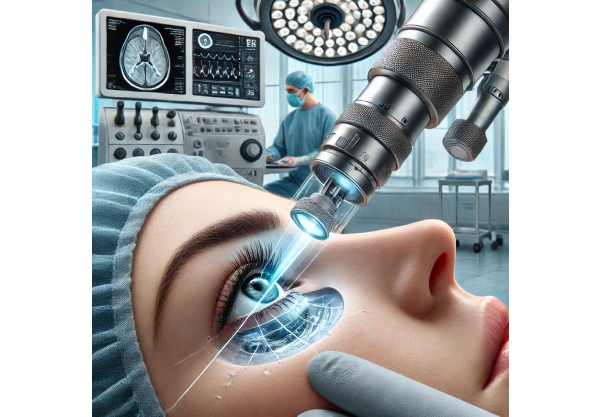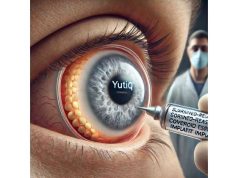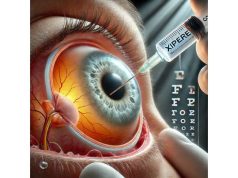
Sebaceous gland carcinoma of the eyelid is a rare yet highly aggressive malignancy that poses complex challenges for both diagnosis and treatment. Often mistaken for benign conditions, this cancer requires rapid recognition and coordinated care for optimal outcomes. This guide delivers a comprehensive overview—from risk factors and clinical presentation to the most up-to-date therapeutic options, surgical advances, and cutting-edge innovations in management. Whether you’re a patient, caregiver, or healthcare provider, you’ll find practical advice, evidence-based strategies, and future-focused developments, all written in an accessible and supportive tone to empower your decision-making and understanding.
Table of Contents
- Epidemiology and Risk Factors of Eyelid Sebaceous Gland Carcinoma
- Nonsurgical Therapies and Medical Management
- Surgical Approaches and Reconstructive Techniques
- Innovative Treatments and Emerging Technologies
- Clinical Research and Advances on the Horizon
- Frequently Asked Questions
- Disclaimer
Epidemiology and Risk Factors of Eyelid Sebaceous Gland Carcinoma
Sebaceous gland carcinoma (SGC) of the eyelid is an uncommon but formidable eyelid tumor. Understanding its underlying biology, risk factors, and prevalence is essential for timely diagnosis and management.
Definition and Origin
- SGC is a malignant tumor arising from sebaceous glands in the eyelid, most frequently the meibomian glands but also glands of Zeis or caruncle.
- It often masquerades as benign lesions such as chalazion or blepharitis, causing diagnostic delay.
Prevalence and Demographics
- Accounts for 1–5% of all eyelid malignancies globally, but higher prevalence in Asian populations.
- More common in adults over 60, with a female preponderance noted in some studies.
- Rare in children.
Risk Factors
- Chronic sun exposure: UV damage increases risk.
- Prior radiation therapy: Especially to the head and neck.
- Immunosuppression: Including organ transplant recipients.
- Genetic syndromes: Muir-Torre syndrome (a type of Lynch syndrome) predisposes to SGC.
- Chronic inflammation: Recurrent chalazia or persistent eyelid swelling may be linked.
- Ethnicity: Increased risk in some Asian populations.
- Personal history of skin cancers: Especially basal or squamous cell carcinoma.
Clinical Presentation
- Presents as a painless, firm, yellowish nodule or a recurrent chalazion.
- May mimic blepharoconjunctivitis (inflammation of eyelid and conjunctiva).
- Loss of eyelashes (madarosis), thickened eyelid margin, or ulceration may occur.
- Advanced disease can involve regional lymph nodes or orbit.
Diagnostic Evaluation
- Suspicion: Any recurrent or atypical eyelid lesion in an older adult should prompt suspicion.
- Biopsy: Full-thickness incisional or excisional biopsy is mandatory for definitive diagnosis.
- Imaging: MRI or CT for large or invasive tumors, to assess orbital or nodal involvement.
- Sentinel lymph node biopsy: In select cases, to rule out regional metastasis.
Prevention and Early Detection
- Regular skin checks, especially in high-risk individuals.
- Rapid evaluation of persistent or atypical eyelid lumps.
- Educate patients on warning signs: non-healing, yellowish, firm masses; recurrent “styes”; eyelash loss; chronic eyelid inflammation.
Nonsurgical Therapies and Medical Management
While surgical excision is the mainstay for most cases, there are situations where nonsurgical options are necessary or complementary. These therapies are also important in the setting of advanced or unresectable disease, patient preference, or as adjuncts to surgery.
Conventional Pharmacological Treatments
- Topical chemotherapy: 5-fluorouracil or mitomycin C may be considered in select, superficial cases, or as adjuncts for pagetoid spread (intraepithelial disease).
- Systemic chemotherapy: Reserved for advanced, metastatic, or recurrent disease. Agents include platinum-based drugs, taxanes, and anthracyclines. Effectiveness is limited and side effects must be considered.
- Immunomodulatory agents: Interferons have been used off-label for conjunctival involvement.
- Hormonal therapies: Rarely, androgen receptor blockers may be tried in hormone-sensitive cases.
Radiation Therapy
- External beam radiation: Sometimes used as definitive therapy when surgery is not possible due to patient frailty, tumor extent, or anatomical location.
- Adjuvant radiotherapy: May be recommended after surgery in cases of positive margins, orbital invasion, or lymph node metastasis.
- Brachytherapy: A focused radiation technique, may be an option in specialized centers.
Targeted and Immunotherapies
- PD-1/PD-L1 inhibitors: These immune checkpoint inhibitors are under investigation for advanced SGC, with some promising early results.
- Targeted molecular therapies: Research is ongoing into the use of therapies directed at tumor-specific mutations or growth pathways.
Supportive and Palliative Care
- Pain control: Analgesics and anti-inflammatories as needed.
- Management of side effects: Including dry eye, irritation, and skin reactions.
- Psychological support: Counseling, support groups, and patient education to help manage anxiety and improve quality of life.
Practical Advice for Patients
- Ask your oncologist if any non-surgical treatments are appropriate for your stage and type of SGC.
- Always inform your care team of new symptoms or medication side effects promptly.
- Maintain careful skin and eyelid hygiene.
Surgical Approaches and Reconstructive Techniques
Surgery remains the cornerstone of curative treatment for eyelid sebaceous gland carcinoma. Success depends on complete tumor removal while preserving eyelid function and appearance.
Surgical Planning and Principles
- Complete excision with negative margins: The primary goal is to remove all cancerous tissue, as incomplete excision leads to high recurrence.
- Margin-controlled surgery: Mohs micrographic surgery or frozen section control provides immediate margin assessment, lowering recurrence rates.
- Wide local excision: Typically 4–6 mm of healthy tissue is removed around the tumor.
Types of Surgical Procedures
- Simple excision: For small, well-localized tumors not involving the eyelid margin.
- Full-thickness eyelid resection: For tumors involving the entire eyelid or margin.
- Map biopsies: Multiple samples from adjacent conjunctiva to detect pagetoid spread.
- Sentinel lymph node biopsy: To assess for regional metastasis, especially in tumors larger than 10 mm or with high-risk features.
- Orbital exenteration: Rarely, in advanced cases where the orbit is invaded.
Eyelid and Periocular Reconstruction
- Direct closure: For small defects.
- Local flaps: Tissue is borrowed from adjacent eyelid or cheek to reconstruct larger defects while preserving eyelid contour and function.
- Free grafts: Skin or mucosal grafts from elsewhere on the body to restore normal anatomy.
- Canalicular and conjunctival reconstruction: Specialized techniques to restore tear drainage and protect the eye surface.
- Staged reconstruction: Complex or large defects may require multiple surgeries for best results.
Adjunctive Surgical Techniques
- Cryotherapy: May be used at tumor edges to destroy residual cancer cells.
- Amniotic membrane transplantation: For conjunctival surface reconstruction.
Postoperative Care
- Close monitoring: Early detection of recurrence, infection, or wound complications.
- Eyelid hygiene: Gentle cleansing and ointment as prescribed.
- Scar management: Silicone gels, massage, and (when appropriate) steroid injections for excessive scarring.
- Regular follow-up: Lifelong surveillance is essential due to risk of local recurrence and secondary tumors.
Practical Guidance
- Clarify with your surgeon which type of reconstruction will be used.
- Adhere strictly to post-op care instructions for optimal healing.
- Report any changes in vision, eyelid function, or appearance without delay.
Innovative Treatments and Emerging Technologies
Recent years have witnessed promising advances in the diagnosis and management of eyelid sebaceous gland carcinoma, offering new hope for improved outcomes and reduced morbidity.
Advanced Diagnostic Tools
- High-resolution imaging: Optical coherence tomography (OCT), confocal microscopy, and high-frequency ultrasound help delineate tumor extent.
- Molecular diagnostics: Genetic and immunohistochemical markers to differentiate SGC from benign lesions or other malignancies.
Intraoperative Innovations
- Real-time margin assessment: Rapid onsite evaluation with confocal or fluorescence microscopy speeds up surgery and improves margin control.
- Robotic-assisted microsurgery: Offers improved precision in complex reconstructions, though still largely investigational.
Emerging Systemic Therapies
- Checkpoint inhibitors: Clinical trials of pembrolizumab and nivolumab for advanced or metastatic SGC.
- Targeted gene therapies: Trials investigating therapies directed at specific tumor mutations.
Regenerative and Tissue Engineering Approaches
- Bioengineered skin and conjunctival grafts: Enhance wound healing and restore anatomy.
- Stem cell-based reconstruction: Early studies show promise for restoring function and appearance after extensive resections.
AI and Digital Health
- Machine learning algorithms: Improve early detection and help stratify risk based on imaging and pathology.
- Tele-oncology: Digital platforms facilitate follow-up and multidisciplinary management for complex cancer cases.
Patient-Centered Innovations
- Scar minimization protocols: Combining fractional laser therapy and topical agents.
- Rehabilitative services: Custom ocular prosthetics and counseling for patients after major reconstructive surgery.
Practical Steps for Patients
- Inquire about clinical trials or innovative therapies available at your treatment center.
- Consider multidisciplinary care for complex or advanced cases.
Clinical Research and Advances on the Horizon
The field of eyelid sebaceous gland carcinoma management is rapidly evolving. Ongoing and future research efforts aim to improve survival, reduce recurrence, and optimize quality of life.
Key Research Focus Areas
- Early detection: Improved imaging, liquid biopsy, and AI-driven screening.
- Minimally invasive surgery: Refinement of endoscopic and robotic techniques.
- Novel therapeutics: Checkpoint inhibitors, CAR-T cell therapy, and gene editing approaches.
- Personalized medicine: Molecular profiling to tailor treatment plans to individual tumor biology.
Notable Current Clinical Trials
- Pembrolizumab and nivolumab for advanced eyelid SGC.
- New margin-control technologies in Mohs surgery.
- Combination therapies pairing surgery with targeted immunotherapy.
- Studies on regenerative grafts and stem cell adjuncts.
Emerging Trends
- Integration of AI and telemedicine in post-treatment monitoring.
- Risk-adapted surveillance strategies for high-risk survivors.
- Improved quality of life measures, including cosmetic outcomes and psychological support.
Staying Informed
- Discuss participation in clinical research with your specialist.
- Access up-to-date clinical trial databases for newly launched studies.
Frequently Asked Questions
What are the early warning signs of eyelid sebaceous gland carcinoma?
Early signs include a painless, firm, yellowish eyelid nodule, recurrent chalazion, loss of eyelashes, or persistent eyelid swelling. Any non-healing lesion should prompt evaluation by an ophthalmologist.
How is eyelid sebaceous gland carcinoma diagnosed?
Diagnosis is made by surgical biopsy and confirmed by pathology. Imaging and lymph node assessment may be necessary to stage the cancer and plan treatment.
What are the main treatments for eyelid sebaceous gland carcinoma?
The primary treatment is surgical excision with clear margins, often with eyelid reconstruction. Radiation or chemotherapy may be needed for advanced or recurrent cases.
Can sebaceous gland carcinoma of the eyelid spread to other parts of the body?
Yes, it can spread to lymph nodes, nearby tissues, and less commonly to distant organs. Early detection and treatment are vital to reduce the risk of metastasis.
Are there new treatments available for advanced eyelid sebaceous gland carcinoma?
Innovative therapies, including immune checkpoint inhibitors, targeted therapies, and regenerative techniques, are being investigated in clinical trials and may be available at specialized centers.
What is the long-term outlook after treatment?
With early detection and comprehensive care, many patients achieve cure. Lifelong follow-up is recommended as recurrence can occur years after treatment.
Disclaimer
This article is for educational purposes only and should not be considered a substitute for professional medical advice, diagnosis, or treatment. Always seek the guidance of your physician or qualified health provider with any questions you may have regarding a medical condition.
If you found this resource helpful, please share it on Facebook, X (formerly Twitter), or your favorite social media platform, and follow us for more expert medical guidance. Your support helps us continue to create quality health content for the community!










